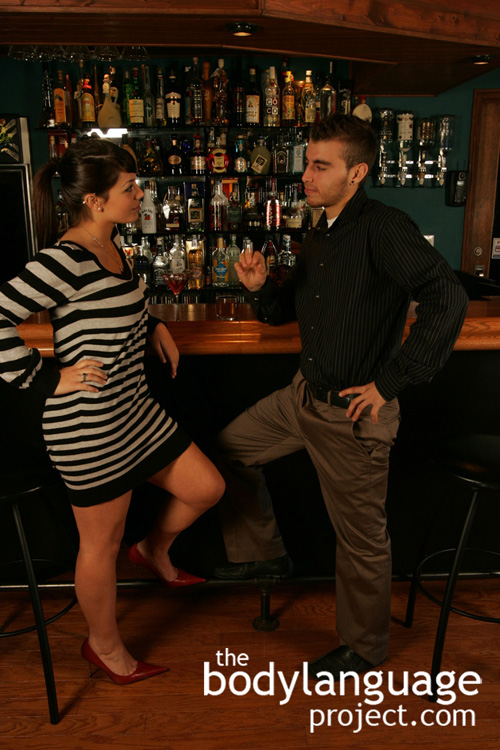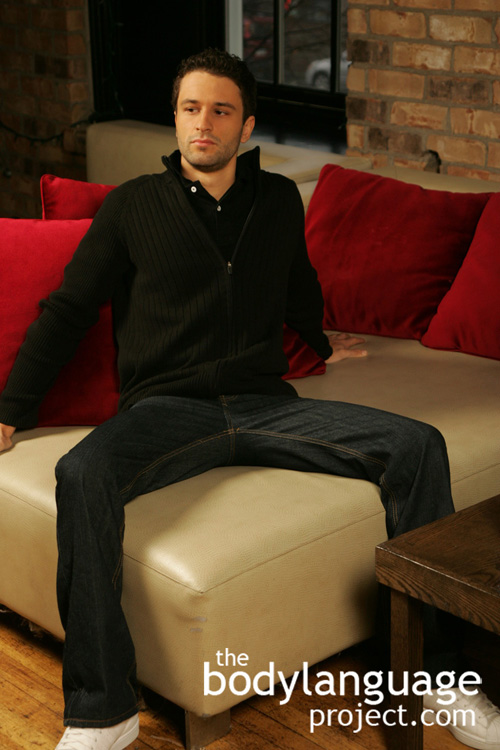1. You’re “cold reading” which means you don’t have a lot of time to play around – so let’s get going already. First define the “context.” This is the easy part. Are you in a business, dating, public or friendly setting? Are you playing poker? The context says it all. You shouldn’t look for sexual cues while reading your sister’s body language! Her coy smile probably doesn’t mean she wants to date you! In the office, your boss might be clenching his fists, but he’s unlikely to smash your face in! When that guy in the bar starts balling his fists, well, that’s another story!
Why? “Context” is an important factor to consider while reading people. We often hear about verbal statements that are taken out of context and in this same way, we can take nonverbal language out of context as well. “The guy was obviously lying, he was scratching his face and neck and could barely sit still” might be accurate when being grilled by a panel of the media over missing fund money, but in the context of being attacked by a swarm of killer bees, not accurate at all! Concluding that someone is cold hearted from a single meeting is another case of ignoring context. We often think people are shy after a first meeting, but are surprised when over time they open up and are actually quite expressive and talkative.
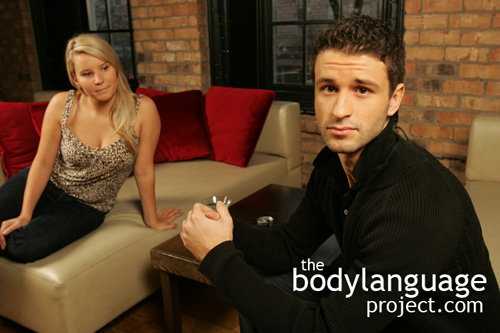
Some people normally clasp their hands together. We need to watch for sudden changes in body language beyond the baseline to discover hidden meaning.
2. Get to know a person to discover their “baseline.” A “baseline” is the set of nonverbal mannerisms that a person will use when relaxed. Find out how a person usually comports themselves and if possible in more than one situation. Experts agree that reading body language requires a comparison between relaxed body language and body language that arises during emotional provocation.
Why? “Baselining” is probably one of the most important and often overlooked aspects of reading body language. It refers to the “normal” motions that populate the repertoire of each and every person on the planet. “Normal” here is the operative word. We can’t even begin to read someone until we first have their baseline pegged. For example, to read someone that is normally flighty and constantly moving as agitated, is wrong since they are merely acting out their particular “idiosyncratic nonverbal behaviour.” That is, the body language that is particular to specific people and that makes up their repertoire, or basket of cues, considered normal for them. By establishing a baseline it will be possible to catch sudden changes in body language. This is the ultimate purpose to establishing a person’s baseline. Without catching the changes, body language loses its ability to indicate exactly what is going on.
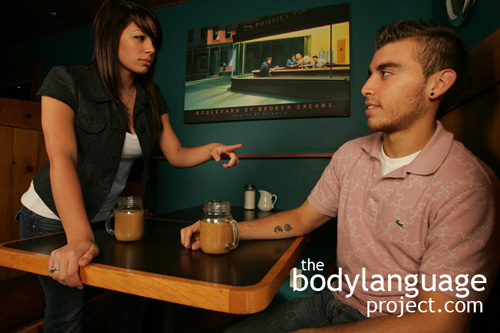
Most agree that we need at least four independent signals before we can reliably make conclusions about a persons body language. How many signals can you spot in this photo? How does each person feel?
3. Next try to find at least four cues that stand out in a “cue cluster.” Look for the big stuff first like arm and leg crossing (closed body) or uncrossed (dominant and open), head tilts (interest), head down (judgment), head back (disapproval), head even (contemplating) palm up (offering/honest) palm down (authoritative), eye contact (strong or fleeting), ventral orientation (toward-liking, distancing-disliking/disinterest), proximity of body as well, such as arms and legs (close-liking, far-disliking), type of smile (even-honest, uneven-feigned/stressed), body size, large (dominant/open), small submissive/closed), touching (liking/influencing), any forms of clenching, pinching or scratching (discomfort/pacifying), use of barriers in blocking (discomfort/shielding), lip compression or biting (negative thoughts).
Why? “The rule of four”, and it’s an important one, says that you can’t attach meaning to a single gesture and accurately judge a person – you need more than one, preferably at least four. The rule of four calls on us to read cues alongside other cues commonly referred to as “cue clusters” before drawing conclusions. The more cues that appear in association with other cues, the more accurate one can be about the underlying meaning. It isn’t impossible to see cue clusters in the six’s and sevens or higher. However, most agree that four independent signals is enough to positively identify true meaning.
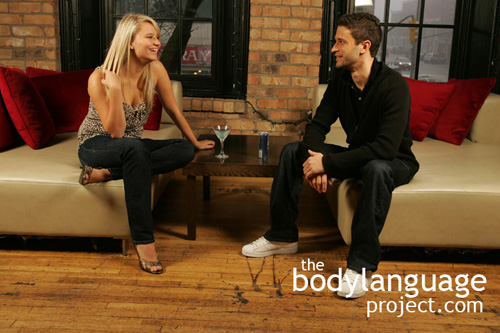
Most experts agree that we need at least four independent cues before definitively uncovering hidden meaning. Can you spot the hidden language in this photo?
4. Next, check for “congruence.” The word congruence, as it relates to body language, refers to the degree to which body language cues in a person matches one another in terms of their meaning. If, for example, one is speaking honestly with the palms up (an honest gesture) we can say that the body language and verbal language are congruent. That is, honest words match up with honest body language. A child with their hands in their pockets (dishonest gesture) speaking about how they didn’t steal a cookie is incongruent since their body language does not match their verbal language. To extend this example, someone might remove their hands from their pockets, do a palms up display while relaying information, and then return their hands to their pockets. Their palm up display is incongruent with returning their hands to their pockets. This person might be lying in a worst case, and at best, nervous.
Why? A lack of congruence can lead us down the wrong path or when we see inconsistency can tip the body language reader off on a ruse.
5. Is “mirroring” happening? Are similar postures and gestures being imitated between two people? Is rapport being built? Mirroring describes body postures, body positions and gestures that are held in unison or echoed a few seconds later, across people as they interacting. Mirroring can be matched to create perfect flow through changing dialect, speech rate or tempo, pitch, tonality, voice inflection, use of words, and even accent. The process by which this happens is called “communication accommodation theory.” Mirroring can cut so deep that breathing, blinking, and even our heart rates can beat in unison. When full mirroring appears it is as if each person is looking into the mirror and seeing their reflection.
Why? Mirroring or “isopraxis” is as important to lifelong friends as to strangers meeting for the first time, since mirroring is a way to test and maintain the level of rapport, or connectivity being established, between two people or groups of people. We mirror as a form of bonding with one another, and it happens without our conscious awareness. In ancient times, mirroring would have created group cohesion and identity. Sports groups, riot officers, firemen, and a myriad of occupations all wear the same uniform. It is this dress that formulates the beginnings of the behaviour that eventually leads to a group’s ability to functioning in unison. Mirroring says that we are on the same page. It’s like saying look at the two of us, we walk the same, talk the same and our bodies move in unison, therefore we must agree!
6. Pretend they are nude! My rule of thumb on “macrogestures”, the big stuff, like arm and leg crossing, is to picture people nude. This gives the body language reader a quick assessment of a persons level of dominance or submission and comfort or discomfort. Are their hands covering their genitals? Are they hiding their breasts or chest with arm crossing, are their legs splayed out putting their ‘junk’ out on display, are their arms raised up high defying gravity showing no worries, are they cowering over in a fetal position? Each posture leaves cues as to the emotional state of a person through their relative exposure.
Why? The genitals are tied to our emotional state and when we feel insecure or submissive we cower to protect them. Our hands will “fig leaf” over our private areas or our legs will slam closed. Body language cues came about over our primitive evolutionary history as the naked ape, so it naturally follows that they developed without clothing or coverings. Clothing provides a blanket to hide our genitals, or chest and breasts, our feet and so forth, but the hardwiring in our brains functions as if they are totally absent. Imagine, for example, a full body steeple, sometimes called “hooding” where the arms are placed behind the head and the body leans back with the legs spread wide open – a crotch display! It is the way a proud (or arrogant) man sits to put his full package on display to the benefit of others. True, it is slightly less offensive with clothing on, but it still carries the exact same meaning since its true intentions were delivered as if the clothing were absent.
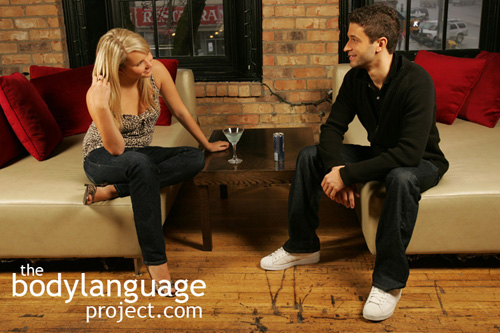
Sitting on the feet or tucking them in can be a sign of high comfort because it makes it difficult to make a quick escape.
7. When in doubt check the feet. Are the feet bouncing (nervous energy/wanting to leave or excited), are they aimed toward the door (desire to exit), aimed upward (gravity defying-happy), standing crossed (negative thought but not ready to leave), pulled under the chair (insecure), wrapped around the chair (ejector seat-negative thoughts/bracing), extended toward a person (attracted/liking/interested), pulled in (dislike, fear, disinterest), feet together while standing (child-like, at attention-ready to take orders).
Why? The feet are honest! It has been said that the feet are the most honest part of the body as it applies to the language they emit. Millions of years ago, we gave up quadrupedalism to walk upright leaving our feet to the dirt. While our hands busied themselves with other complex tasks like fire building, making clothing and shelters, and throwing spears, our legs were relegated to more primitive activities like locomotion.
The feet, unlike the hands, carried out more traditional tasks like escaping predators, avoiding hot sand or coals from the fire, leaping from slithering snakes or poisonous spiders, or navigating rough rocking river bottoms. The feet were therefore connected more to the reptilian brain which reacts to stimuli directly instead of contemplating higher order tasks that require planning. When we’re frightened it doesn’t take much to put our feet in gear. We quickly and instinctively get them tucked under our legs and coiled up, or freeze instantly or pull them up onto a chair when startled by a mouse that catches our eye scampering across the shadows of a room.

When in doubt, trust your gut. Emotions often appear as microexpressions in fractions of seconds, so if we feel a certain way, it’s probably for good reason.
8. Trust your intuition. When all else fails, how do you feel about the person you are reading? Do they fit into one of the six primary emotions (happy, sad, fearful, disgusted, surprised, or angry)? Do they like or dislike what’s being said? Are they flirting, playing hard to get or are they hiding contempt? When it really comes down to it, our intuition is usually quite accurate. Knowing body language helps reinforce what we already know about our targets. So when doubtful, trust your gut!
To really learn how to read body language switch over to Body Language Project: The Only Book On Body Language That Everybody Needs To Read.

